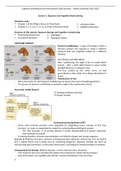Cognitive and Behavioural Interventions (CBI) Lectures – Leiden University 2021-2022
Lecture 1: Exposure and Cognitive Restructuring
Literature exam
Chapter 1 of the Wright, Basco, & Thase Book Literature slides
Chapter 1, 2, 4, 6, 8, 9, 13, & 14 of the O’Donohue Book Additional literature
Structure of this Lecture: Exposure therapy and Cognitive restructuring
Theoretical background Examples
Procedural variations Research issues
EXPOSURE THERAPY
Classical conditioning = a type of learning in which a
stimulus acquires the capacity to evoke a reflexive
response that was originally evoked by a different
stimulus.
John Watson and Little Albert
After conditioning, the sight of the rat made Albert
scream – after a while Albert began to show similar
terrified behaviors to Watson’s face.
The fear evoked by the white, furry, rat had
generalized to other white, furry things, like Watson’s
beard.
Maintenance of fear
- We’ve learned so far that classical conditioning can lead to the onset of (pathological) fear.
- The process of operant conditioning is needed to explain the maintenance of fear.
Two-factor model Mowrer
Studying avoidance learning
Escape reaction
Emotional processing theory (PET)
- These early learning accounts were expanded by integrating Lang’s concept of the ‘fear
structure’ to create a comprehensive model for understanding pathological anxiety.
o The “fear structure” is an anxiety memory in which representations of stimuli, responses,
and meanings are stored.
- In anxiety disorders, stimulus representations are linked to danger and strong responses.
Example of PTSD fear structure: someone is threatened with a pistol by a blond man It can lead to
that a regular blond man is being seen as something dangerous. Exposure therapy can focus on
restructuring that connection, so that every blond man is not leading to anxiety/feelings of unsafety.
Consequences for therapy: Effective therapy = correct fear-structure. Demands:
- Fear-structure has to be activated (the patient must experience anxiety during therapy).
- New information, incompatible with old info, must be introduced in fear structure.
1
, Cognitive and Behavioural Interventions (CBI) Lectures – Leiden University 2021-2022
What is Exposure Therapy?
- Exposure therapy purposefully generates anxiety by exposing an individual repeatedly too fear-
provoking stimulus.
- In the absence of repeated aversive outcomes.
- Which leads to extinction through inhibitory learning.
Exposure therapy for anxiety
What is exposure therapy? 3 types of exposure:
1. Exposure to external feared stimuli (in vivo exposure)
2. Exposure to imaginal stimuli (in vitro/imaginal exposure)
3. Exposure to physical (internal) stimuli (interoceptive exposure)
For: Anxiety disorder (e.g., spiders), panic disorders, social anxiety disorder, GAD, OCD, PTSD.
Massed vs. spaced exposure (between session)
Must ET be conducted at its max length? (e.g., 3-4 hours a day, 5 days a week)
- Pro massed ET: quick improvement enhances motivation/less opportunity for avoidance.
- Pro spaced ET: less return of fear/more acceptable and practical to patients.
- Current practice: mostly spaced.
Gradual vs. intense exposure
- Should ET be as intense as possible or gradual (beginning with the least fearful stimulus)?
o Flooding exposes the person to the most anxiety-producing stimulus.
o Graduated exposure begins with the least fearful stimulus.
- Pro-flooding: quicker results than graduated ET.
- Pro graduated ET: less dropout and non-compliance than flooding.
- Practice: mostly gradual.
2
, Cognitive and Behavioural Interventions (CBI) Lectures – Leiden University 2021-2022
Attention vs. distraction
- Distraction: regulates too high levels of anxiety (positive effect on short term), but also acts as
cognitive avoidance (hampering anxiety activation and habituation_ negative effect on long
term.
- The long-term effects on focused attention during ET are favorable that ….
Therapist-aided vs. self-directed ET
- Is the aid of another person (therapist/family member) necessary for successful ET?
- Therapist- or spouse-aided ET somewhat more effective than self-directed ET.
- Practice: involvement of others in first phase of ET.
In vivo vs. in vitro …
- Is exposure in vivo (in real life) just as effective as in vitro (in imagination)?
o In vivo ET is more effective than in vitro ET. Every therapy should include exposure in vivo!
o Imaginal exposure to motivate patients to start in vivo exposure and in case of exposure to
special stimuli (e.g., reexperiences in PTSD or fear of flying).
Arachnophobia = the intense fear of spiders, or spider phobia.
COGNITIVE RESTRUCTURING
Cognitive models
- Cognitive models of psychopathology propose that problems in human behavior and emotion are
often the consequence of biases, distortions or inadequacies in the interpretation or evaluation
of life events.
- The role of thinking is emphasized as influencing behavior and emotions.
- The cause of these biases can be biological, the result of socialization or negative life events.
Albert Ellis
1913-2007 American Psychologist who in 1955 developed Rational Emotive Therapy. One of the
originators of the cognitive revolution (opposing radical behaviorism). Originally a psychoanalyst.
Influenced by i.e.: Alfred Korzybski (human knowledge is limited by language) and Stoicism (personal
ethics informed by logic). Albert Ellis’s Rational Emotive Therapy:
- An important precursor to Beck’s work.
- Pathology is due to irrational beliefs.
- Allergy for the “Should” statement and the word “awfulizing” (e.g., saying that it’s so awful). Low
frustration tolerance.
The ABC Model (extension with E and D)
Aaron T. Beck’s cognitive model
- Depressed and anxious individuals have typical distortions in their thinking.
3





